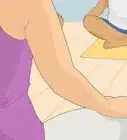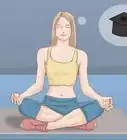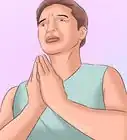This article was co-authored by Michiko Takatani. Michiko Takatani is a Sexual Health, Yoga & Tantra Specialist and the Founder of Solar Tantra School. With nearly 20 years of experience, she specializes in a combination of Kundalini yoga and Tantra. She holds a Kundalini Yoga Certification from the Kundalini Research Institute. Additionally, her Solar Tantra School in New York has a 5-star rating.
There are 18 references cited in this article, which can be found at the bottom of the page.
This article has been viewed 319,012 times.
Sun salutations, or surya namaskar in Sanskrit, are an integral and flowing sequence, or vinyasa, for any yoga practice.[1] There are different variations of sun salutations.[2] You should start every yoga practice with several rounds of sun salutations to warm yourself up and help gain your focus, or drishti, for your practice.[3] Anyone from experienced yogis to beginners can enjoy the benefits of practicing sun salutations.
Steps
Practicing Surya Namaskar A
-
1Learn the benefits of sun salutations. Surya namaskar is an important foundational vinyasa in yoga that will energize, calm, and relax you. It can also stretch your entire body while strengthening your arms, shoulders, and legs. Practicing regularly may aid digestion, and relieve back pain.[4]
- Talk to your doctor before you begin any yoga practice to make sure you’re healthy enough to practice.[5]
- Be careful practicing sun salutations if you have any back, arm, or shoulder injuries. Those with motion disorders, including ear infections, should also be careful.
- Sun salutation makes you more flexible and strengthens muscles. Their expansion and contraction can improve your blood circulation.
- Breathing deeply within these positions helps the respiratory and digestive systems and boosts the immune system.
- All of the above benefits and a more balanced body posture contribute to improved mental health, brain function, and energy.
-
2Stand in tadasana or mountain pose. Start by standing in tadasana, or mountain pose, at the front of a yoga mat. This will allow you to most easily flow into the sun salutation from standing.[6]
- Tadasana, or mountain pose, is when you stand at the front of a yoga mat with your feet hip width apart and your arms at your sides. Gaze forward, spread your toes, and make sure your balance is evenly distributed between both feet.[7]
- Make sure to engage your abdominals and lightly pull your sacrum toward the ground, which is sometimes referred to as engaging your root lock or mula bandha.[8]
- Inhale and exhale evenly through your nose. If you can, make a slight sound like the sea when you breathe. This is called ujayyi breathing and can help you flow through your downward dog more effectively.
Advertisement -
3Place your hands in a prayer position in front of your heart and set an intention. No yoga practice is complete without setting an intention. By taking a few seconds to dedicate your practice to something, you may be more effective at doing sun salutations.
- Lightly touch the bases of your palms, then the palms themselves, and finally your fingers to make prayer hands. You can leave a small space between your palms if you like to let energy flow.
- If you don’t know what your intention is, consider something as simple as “letting go.”
-
4Raise your prayer hands into an upward salute. Once you’ve set your intention, inhale and raise your hands towards the ceiling in an upward salute, which is also called urdhva hastasana.[9] Gently arch your back as you look up towards your hands.
- Make sure to completely extend your elbows and reach up through your fingers towards the ceiling. Only tip your head back slightly, making sure not to compress your cervical spine.[10]
- Do this without hunching your shoulders and make sure to keep your chest and heart area open.[11]
- You can take a slight backbend in urdhva hastasana, which is easiest to do by simply pulling down your sacrum, or tailbone.[12]
-
5Exhale and hinge into standing forward bend. Exhale and “plunge” into standing forward bend, which is also called uttanasana.[13]
- It’s important to keep your back straight and hinge forward at your waist as you transition from upward salute (urdhva hastasana) to standing forward bend (uttanasana). It may help you to remember to keep your heart open.[14]
- Plant your palms flat on the floor next to either foot. Your fingers should point forward and be fully spread apart so that your entire palm is pressing into the floor, which will make it easier to flow into the following asanas.
- It’s important to keep your abs engaged and in contact with your thighs.[15] If necessary, bend your knees to keep this contact.
- If your palms don’t reach the floor, put them on blocks so that your entire hand is pressing into the floor.[16]
-
6Inhale and extend your spine into standing half forward bend. Gently inhale and extend your spine into a standing half forward bend, which is also called ardha uttanasana. This position will make it easier for you to enter the following asanas.
-
7Exhale and step or jump back to four limbed staff pose. Depending on how experienced you are at yoga, either step or jump back to four-limbed staff pose, which is called chatturanga dandasana in Sanskrit.[19] This is one of the most challenging positions and sequences in yoga, and may require years of practice to master.
- If you are a beginner, you’ll want to step back to downward facing dog and then lower half down to the ground into chatturanga dandasana. Your upper arms should be parallel to the floor.[20]
- Those who have more experience with yoga can jump back and complete an end up in chatturanga dandasana.[21]
- Make sure your body is completely even: do not sink your hips or collapse your abdominals. Remaining strong through your core is key to this asana, or exercise. Your upper arms should form a 90 degree angle with the floor and should be close to your side ribs.[22]
- If you are not strong enough to hold yourself in this position, you can drop your knees to the floor until you build enough strength to support yourself.[23]
- Your toes should be flexed.[24]
-
8Inhale and roll over your toes to upward facing dog. From chatturanga dandasana, roll over your toes to an upward facing dog position, or urdhva mukha savasana. This will make it easier to transition to the next and your final position, downward facing dog.[25]
- Your hands should be in the same position in which they started and the palms should be fully pressing against the floor.[26]
- Use your flexed toes to roll over on to the backs of your feet. Keep your thighs engaged and off of the floor as you push your chest through your arms. Gently arch your back, open your chest, and look up at the ceiling.[27]
- Your toes may not be flexible enough to allow you to roll over them. If this is the case, modify the pose by picking up your feet and placing the backs on the floor.[28]
- Pulling your sacrum towards your heels will protect your back and keep the position from hurting.[29]
-
9Exhale and roll over your toes into downward facing dog. You’ve reached the final asana and a well-earned rest. Exhale and roll back over your toes so that your body ends up in an inverted “V” shape, which is downward facing dog or adho mukha savasana in Sanskrit. This position should feel calming and allow you to rest as you get deeper into the asana, or pose.[30]
- Keep your palms pressing flat against the floor and your abs engaged[31]
- Roll your shoulders down your back and arms inward so the eyes of your elbows are facing one another.[32]
- Your toes may not be flexible enough to allow you to roll over them. If this is the case, modify the pose by picking up your feet and placing the backs on the floor.
- Your heels may or may not touch the floor, depending on how flexible your lower back, hamstrings, and calf muscles are. The more you practice, the easier it will be to get your heels to the floor.[33]
- Keep lifting your sitting bones towards the ceiling.[34]
- You can keep your gaze towards your navel, but make sure you’re head is hanging comfortably.[35]
-
10Exhale and transition back to ardha uttanasa. In order to finish the sun salutation, you need to end up in tadasana.[36] After five breaths in downward dog, bend your knees to your chest and either jump or step forward into ardha uttanasana, or half standing forward bend.
-
11Inhale and extend your spine into standing half forward bend. Gently inhale and extend your spine back into ardha uttanasana. This position will make it easier for you to re-enter uttanasana.[37]
- Make sure to keep your abs engaged, spine straight, and palms firmly planted on the floor next to your feet.[38]
-
12Exhale and fold forward into uttanasana. Hinging forward completely, exhale and fold completely forward into standing forward bend, or uttanasana. You’re almost done with your first round of surya namaskar A!
-
13Inhale and rise into into an upward salute. You’re ready to come full circle like the sun. Inhale and rise up radiantly by bringing your prayer hands towards the ceiling in urdhva hastasana.[39] Gently arch your back as you look up towards your hands.
- Remember to keep your spine straight as you rise into urdhva hastasana.[40]
-
14Exhale and return to tadasana. Bring your prayer hands back to your sides as you exhale and return to tadasana. Take a minute or two to enjoy the heart-opening effects and energizing effects of surya namaskar.[41]
- You can do as many more sun salutations as you like to help yourself warm up.
- Consider trying different variations of surya namaskar to help yourself warm up.
Practicing Surya Namaskar B
-
1Place your hands in a prayer position in front of your heart and set an intention. No yoga practice is complete without setting an intention. By taking a few seconds to dedicate your practice to something, you may be more effective at doing sun salutations.
- Lightly touch the bases of your palms, then the palms themselves, and finally your fingers to make prayer hands. You can leave a small space between your palms if you like to let energy flow.
- If you don’t know what your intention is, consider something as simple as “letting go.”
-
2Stand in tadasana or mountain pose. Start by standing in tadasana, or mountain pose, at the front of a yoga mat. This will allow you to most easily flow into the sun salutation from standing.[42]
- Tadasana, or mountain pose, is when you stand at the front of a yoga mat with your feet hip width apart and your arms at your sides. Gaze forward, spread your toes, and make sure your balance is evenly distributed between both feet.[43]
- Make sure to engage your abdominals and lightly pull your sacrum toward the ground, which is sometimes referred to as engaging your root lock or mula bandha.[44]
- Inhale and exhale evenly through your nose. If you can, make a slight sound like the sea when you breathe. This is called ujayyi breathing and can help you flow through your downward dog more effectively.
-
3Inhale, raise your prayer hands and bend your knees into chair pose. Taking a breath in, bend your knees while raising your prayer into chair pose, which is called uttkatasana in Sanskrit.[45] Gently arch your back as you look up towards your hands.
- Make sure to completely extend your elbows and reach up through your prayer hands towards the ceiling.[46]
- Do this without hunching your shoulders and make sure to keep your chest and heart area open.[47]
- Bend your knees deeply and try and get them parallel to the floor.[48]
- Pull your shoulder blades down your back and tilt your sacrum, or tailbone towards the floor.[49]
-
4Exhale and hinge into standing forward bend. Exhale and hinge forward into standing forward bend, which is also called uttanasana.[50]
- It’s important to keep your back straight and hinge forward at your waist as you transition from upward salute (urdhva hastasana) to standing forward bend (uttanasana). It may help you to remember to keep your heart open.[51]
- Plant your palms flat on the floor next to either foot. Your fingers should point forward and be fully spread apart so that your entire palm is pressing into the floor, which will make it easier to flow into the following asanas.
- It’s important to keep your abs engaged and in contact with your thighs.[52] If necessary, bend your knees to keep this contact.
- If your palms don’t reach the floor, put them on blocks so that your entire hand is pressing into the floor.[53]
-
5Inhale and extend your spine into standing half forward bend. Gently inhale and extend your spine into a standing half forward bend, which is also called ardha uttanasana. This position will make it easier for you to enter the following asanas.
-
6Exhale and step or jump back to four limbed staff pose. Depending on how experienced you are at yoga, either step or jump back to four-limbed staff pose, which is called chatturanga dandasana in Sanskrit.[56] This is one of the most challenging positions and sequences in yoga, and may require years of practice to master.
- If you are a beginner, you’ll want to step back to downward facing dog and then lower half down to the ground into chatturanga dandasana. Your upper arms should be parallel to the floor.[57]
- Those who have more experience with yoga can jump back and complete an end up in chatturanga dandasana.[58]
- Make sure your body is completely even: do not sink your hips or collapse your abdominals. Remaining strong through your core is key to this asana, or exercise. Your upper arms should form a 90 degree angle with the floor and should be close to your side ribs.[59]
- If you are not strong enough to hold yourself in this position, you can drop your knees to the floor until you build enough strength to support yourself.[60]
- Your toes should be flexed.[61]
-
7Inhale and roll over your toes to upward facing dog. From chatturanga dandasana, roll over your toes to an upward facing dog position, or urdhva mukha savasana. This will make it easier to transition to the next and your final position, downward facing dog.[62]
- Your hands should be in the same position in which they started and the palms should be fully pressing against the floor.[63]
- Use your flexed toes to roll over on to the backs of your feet. Keep your thighs engaged and off of the floor as you push your chest through your arms. Gently arch your back, open your chest, and look up at the ceiling.[64]
- Your toes may not be flexible enough to allow you to roll over them. If this is the case, modify the pose by picking up your feet and placing the backs on the floor.[65]
- Pulling your sacrum towards your heels will protect your back and keep the position from hurting.[66]
-
8Exhale and roll over your toes into downward facing dog. Exhale and roll back over your toes so that your body ends up in an inverted “V” shape, which is downward facing dog or adho mukha savasana in Sanskrit. This position will act as a transition to your next asana.[67]
- Keep your palms pressing flat against the floor and your abs engaged.[68]
- Roll your shoulders down your back and arms inward so the eyes of your elbows are facing one another.[69]
- Your toes may not be flexible enough to allow you to roll over them. If this is the case, modify the pose by picking up your feet and placing the backs on the floor.
- Your heels may or may not touch the floor, depending on how flexible your lower back, hamstrings, and calf muscles are. The more you practice, the easier it will be to get your heels to the floor.[70]
- Keep lifting your sitting bones towards the ceiling.[71]
- You can keep your gaze towards your navel, but make sure you’re head is hanging comfortably.[72]
-
9Inhale and lunge your right leg into Warrior One pose. Take a breath in and lunge your right leg forward while lifting your torso so that it is perpendicular to the floor. Raise your arms into prayer hands and gently lift your ribs and body towards the sky.[73]
- In order to best get into Warrior One, which is called Virabhadrasana One in Sanskrit, turn in your left foot so that your arch is aligned with the heel of your right foot.[74] Keep your left heel firmly anchored to the floor.
- Your knee should be directly over your ankle and your shin perpendicular to the floor.[75] Aim to get your thigh parallel to the floor, which may take some practice.
- Keep your hips parallel and pointing forward.[76]
- It helps to raise your arms, which should be in a prayer pose, as if they were coming directly out of your heart.[77]
- Keep raising your arms as you lift your ribs and prayer towards the sky. This will help give you a slight backbend.[78]
-
10Exhale, step back, and lower into chatturanga dandasana. Taking a breath out, place your palms flat on the floor and step back and then lower your body into chatturanga dandasana. This is a very difficult series and may require significant practice before your master it.[79]
-
11Inhale and roll over your toes to upward facing dog. From chatturanga dandasana, roll over your toes to an upward facing dog position, or urdhva mukha savasana. This will make it easier to transition to the next position, downward facing dog.[80]
- Use your flexed toes to roll over on to the backs of your feet. Keep your thighs engaged and off of the floor as you push your chest through your arms. Gently arch your back, open your chest, and look up at the ceiling.[81]
- Your toes may not be flexible enough to allow you to roll over them. If this is the case, modify the pose by picking up your feet and placing the backs on the floor.[82]
- Pulling your sacrum towards your heels will protect your back and keep the position from hurting.[83]
-
12Exhale and roll over your toes into downward facing dog. Exhale and roll back over your toes so that your body ends up in an inverted “V” shape, which is downward facing dog or adho mukha savasana in Sanskrit. This position will act as a transition to Warrior One on your left side.[84]
- Keep your palms pressing flat against the floor and your abs engaged.[85]
- Roll your shoulders down your back and arms inward so the eyes of your elbows are facing one another.[86]
- Your toes may not be flexible enough to allow you to roll over them. If this is the case, modify the pose by picking up your feet and placing the backs on the floor.
- Your heels may or may not touch the floor, depending on how flexible your lower back, hamstrings, and calf muscles are. The more you practice, the easier it will be to get your heels to the floor.[87]
- Keep lifting your sitting bones towards the ceiling.[88]
- You can keep your gaze towards your navel, but make sure you’re head is hanging comfortably.[89]
-
13Inhale and lunge your left leg into Warrior One pose. Take a breath in and lunge your left leg forward while lifting your torso so that it is perpendicular to the floor. Raise your arms into prayer hands and gently lift your ribs and body towards the sky.[90]
- In order to best get into Warrior One, which is called Virabhadrasana One in Sanskrit, turn in your right foot so that your arch is aligned with the heel of your left foot.[91] Keep your left heel firmly anchored to the floor.
- Your knee should be directly over your ankle and your shin perpendicular to the floor.[92] Aim to get your thigh parallel to the floor, which may take some practice.
- Keep your hips parallel and pointing forward and don’t let your hip bone fall.[93]
- It helps to raise your arms, which should be in a prayer pose, as if they were coming directly out of your heart.[94]
-
14Exhale, step back, and lower into chatturanga dandasana. Taking a breath out, place your palms flat on the floor and step back and then lower your body into chatturanga dandasana. This is a very difficult series and may require significant practice before your master it.[95]
-
15Inhale and roll over your toes to upward facing dog. From chatturanga dandasana, roll over your toes to an upward facing dog position, or urdhva mukha savasana. This will make it easier to transition to the next position, downward facing dog.[96]
- Use your flexed toes to roll over on to the backs of your feet. Keep your thighs engaged and off of the floor as you push your chest through your arms. Gently arch your back, open your chest, and look up at the ceiling.[97]
- Your toes may not be flexible enough to allow you to roll over them. If this is the case, modify the pose by picking up your feet and placing the backs on the floor.[98]
- Pulling your sacrum towards your heels will protect your back and keep the position from hurting.[99]
-
16Exhale and roll over your toes into downward facing dog. Exhale and roll back over your toes so that your body ends up in an inverted “V” shape, which is downward facing dog or adho mukha savasana in Sanskrit. This position will act as a transition to Warrior One on your left side.[100]
- Keep your palms pressing flat against the floor and your abs engaged.[101]
- Roll your shoulders down your back and arms inward so the eyes of your elbows are facing one another.[102]
- Your toes may not be flexible enough to allow you to roll over them. If this is the case, modify the pose by picking up your feet and placing the backs on the floor.
- Your heels may or may not touch the floor, depending on how flexible your lower back, hamstrings, and calf muscles are. The more you practice, the easier it will be to get your heels to the floor.[103]
- Keep lifting your sitting bones towards the ceiling.[104]
- You can keep your gaze towards your navel, but make sure you’re head is hanging comfortably.[105]
-
17Exhale and transition back to ardha uttanasa. In order to finish the sun salutation, you need to end up in tadasana.[106] On your final exhale in adho mukha savasana, bend your knees to your chest and either jump or step forward into ardha uttanasana, or half standing forward bend.
-
18Inhale and extend your spine into standing half forward bend. Gently inhale and extend your spine back into ardha uttanasana. This position will make it easier for you to re-enter uttanasana.[107]
- Make sure to keep your abs engaged, spine straight, and palms firmly planted on the floor next to your feet.[108]
-
19Exhale and fold forward into uttanasana. Hinging forward completely, exhale and fold completely forward into standing forward bend, or uttanasana. You’re almost done with your first round of surya namaskar B!
-
20Inhale, raise your prayer hands and bend your knees into chair pose. Taking a breath in, bend your knees while raising your prayer and return to uttkatasana.[109] Gently arch your back as you look up towards your hands.
- Make sure to completely extend your elbows and reach up through your prayer hands towards the ceiling.[110]
- Do this without hunching your shoulders and make sure to keep your chest and heart area open.[111]
- Bend your knees deeply and try and get them parallel to the floor.[112]
- Pull your shoulder blades down your back and tilt your sacrum, or tailbone towards the floor.[113]
-
21Exhale and return to tadasana. Bring your prayer hands back to your sides as you exhale and return to tadasana. Take a minute or two to enjoy the heart-opening effects and energizing effects of surya namaskar.[114]
- You can do as many more sun salutations as you like to help yourself warm up.
- Consider trying different variations of surya namaskar to help yourself warm up.
Practicing Surya Namaskar C
-
1Place your hands in a prayer position in front of your heart and set an intention. No yoga practice is complete without setting an intention. By taking a few seconds to dedicate your practice to something, you may be more effective at doing sun salutations.
- Lightly touch the bases of your palms, then the palms themselves, and finally your fingers to make prayer hands. You can leave a small space between your palms if you like to let energy flow.
- If you don’t know what your intention is, consider something as simple as “letting go.”
-
2Stand in tadasana or mountain pose. Start by standing in tadasana, or mountain pose, at the front of a yoga mat. This will allow you to most easily flow into Surya Namaskar B.[115]
- Tadasana, or mountain pose, is when you stand at the front of a yoga mat with your feet hip width apart and your arms at your sides. Gaze forward, spread your toes, and make sure your balance is evenly distributed between both feet.[116]
- Make sure to engage your abdominals and lightly pull your sacrum toward the ground, which is sometimes referred to as engaging your root lock or mula bandha.[117]
- Inhale and exhale evenly through your nose. If you can, make a slight sound like the sea when you breathe. This is called ujayyi breathing and can help you flow through your downward dog more effectively.
-
3Raise your prayer hands into an upward salute. Inhale and raise your hands towards the ceiling in an upward salute, which is also called urdhva hastasana.[118] Gently arch your back as you look up towards your hands.
- For a variation on this position, you can hook your thumbs in front of your body and raise your attached arms so that they end up by your ears. Hooking your thumbs may also help you enter a light backbend while pulling your sacrum towards the floor.
- Make sure to completely extend your elbows and reach up through your fingers towards the ceiling. Only tip your head back slightly, making sure not to compress your cervical spine.[119]
- Do this without hunching your shoulders and make sure to keep your chest and heart area open.[120]
- You can take a slight backbend in urdhva hastasana, which is easiest to do by simply pulling down your sacrum, or tailbone.[121]
-
4Exhale and hinge into standing forward bend. Exhale and “plunge” into standing forward bend, which is also called uttanasana.[122]
- It’s important to keep your back straight and hinge forward at your waist as you transition from upward salute (urdhva hastasana) to standing forward bend (uttanasana). It may help you to remember to keep your heart open.[123]
- Plant your palms flat on the floor next to either foot. Your fingers should point forward and be fully spread apart so that your entire palm is pressing into the floor, which will make it easier to flow into the following asanas.
- It’s important to keep your abs engaged and in contact with your thighs.[124] If necessary, bend your knees to keep this contact.
- If your palms don’t reach the floor, put them on blocks so that your entire hand is pressing into the floor.[125]
- If you used the alternative pose with hooked thumbs, bring your attached arms over your head before placing your hands on the floor in uttanasana.
-
5Inhale and extend your spine into standing half forward bend. Gently inhale and extend your spine into a standing half forward bend, which is also called ardha uttanasana. This position will make it easier for you to enter the following asanas.
-
6Exhale and extend into a right-legged lunge. Keeping your palms firmly on the floor, exhale and extend your right leg into a lunge position. This is a transition pose, or asana, and will help you more effectively and smoothly flow through the remaining asanas in Surya Namaskar B.
- It’s important to make sure that your palms are firmly planted on the ground in this pose so that you can easily get into the next asana.
- Push through your right heel for stability.
-
7Pick up the left leg and end up in downward facing dog. In the same exhale as your right-legged lunge, pick up your left leg towards your chest and extend it back. Hinging at your hips, end up with both legs in downward facing dog.
- Push your sitting bones towards the ceiling. You should end up in an inverted “V” position, which is downward facing dog, or adho mukha savasana in Sanskrit.[128] This position should feel calming and allow you to rest as you get deeper into the vinyasa, or series.
- Keep your palms pressing flat against the floor and your abs engaged.[129]
- Roll your shoulders down your back and arms inward so the eyes of your elbows are facing one another.[130]
- You can keep your gaze towards your navel, but make sure you’re head is hanging comfortably.[131]
-
8Inhale and hinge forward to plank pose. From downward dog, inhale and hinge forward at your hips into plank pose, which is called kumbhakasana. Your shoulders should be over your hands and your heels pushing back in plank pose, which resembles a high push up position.
- Make sure to keep your abs engaged and spine long. Don’t pop your bum up.
- You shouldn’t need to adjust your body position when you hinge from adho mukhasavasana to plank pose. Your body is perfectly aligned to have you end up in the right position.
- Your feet should be hip width apart and flexed.
-
9Exhale and lower to ashtanga namaskar. Take a breathe out and lower yourself into knees, chest and chin pose, or ashtanga namaskar. You’ll first lower your knees, then your chest, and then your chin to the ground.
- It’s easiest to get into this position by keeping the energy moving forward. To do this, slightly push off of your toes and place your chest between your hands with your hips raised. This may also ensure that you’re getting a good backbend out of this asana.
- Keep your elbows tucked close to your sides, which may make it easier to slide your chest and chin forward.
-
10Inhale and push forward into cobra pose. Take a breath in and push your chest forward through your hands into cobra pose, or jangasana. Pull your shoulders back and lift your chest and gaze slightly.
- Use the flex of your feet to push your chest forward into cobra. Your ribs should still be on the floor and your hands and elbows close to your sides.
- Once you’re in cobra, place the tops of your feet on the floor.
- This is a light backbend and drawing your shoulders down may help you more comfortably enter the asana.
-
11Exhale and roll over your toes into downward facing dog. Breathe out and roll back over your toes so that your body ends up in an inverted “V” shape, which is downward facing dog or adho mukha savasana in Sanskrit. This position should feel calming and allow you to rest as you get deeper into the asana, or pose.[132]
- Keep your palms pressing flat against the floor and your abs engaged.[133]
- Roll your shoulders down your back and arms inward so the eyes of your elbows are facing one another.[134]
- Your toes may not be flexible enough to allow you to roll over them. If this is the case, modify the pose by picking up your feet and placing the backs on the floor.
- Your heels may or may not touch the floor, depending on how flexible your lower back, hamstrings, and calf muscles are. The more you practice, the easier it will be to get your heels to the floor.[135]
- Keep lifting your sitting bones towards the ceiling.[136]
- You can keep your gaze towards your navel, but make sure you’re head is hanging comfortably.[137]
- Inhale and exhale steadily for 5 breaths and then prepare to end the sun salutation.[138]
-
12Inhale and lunge your right and then your left leg forward. You’re almost done with this round of sun salutations. Taking a breath in, lunge your right foot forward followed immediately by your left.
-
13Exhale and fold forward into uttanasana. In order to finish the sun salutation, you need to end up in tadasana.[139] Hinging forward completely, exhale and fold completely forward into standing forward bend, or uttanasana. You’re almost done with your first round of surya namaskar C!
-
14Inhale and rise into an upward salute. You’re ready to come full circle like the sun. Inhale and rise up radiantly by bringing your prayer hands towards the ceiling in urdhva hastasana.[140] Gently arch your back as you look up towards your hands.
- Remember to keep your spine straight as you rise into urdhva hastasana.[141]
- If you did the arm variation at the beginning with hooked fingers, make sure to do that as you end, too.
-
15Exhale and return to tadasana. Bring your prayer hands back to your sides as you exhale and return to tadasana. Take a minute or two to enjoy the heart-opening effects and energizing effects of surya namaskar.[142]
- You can do as many more sun salutations as you like to help yourself warm up.
Things You'll Need
- Yoga mat
- Comfortable clothing
References
- ↑ http://www.yogajournal.com/article/beginners-sequences/shine/
- ↑ http://www.yogajournal.com/article/beginners-sequences/shine
- ↑ http://www.yogajournal.com/article/philosophy/the-eye-of-the-beholder/
- ↑ http://www.yogajournal.com/article/beginners-sequences/shine/
- ↑ http://www.yogajournal.com/article/beginners-sequences/shine/
- ↑ http://www.yogajournal.com/pose/mountain-pose/
- ↑ http://www.yogajournal.com/pose/mountain-pose/
- ↑ https://yogainternational.com/article/view/a-beginners-guide-to-mula-bandha-root-lock
- ↑ http://www.yogajournal.com/pose/upward-salute/
- ↑ http://www.yogajournal.com/pose/upward-salute/
- ↑ http://www.yogajournal.com/article/beginners-sequences/shine/
- ↑ http://www.yogajournal.com/article/beginners-sequences/shine/
- ↑ http://www.yogajournal.com/pose/standing-forward-bend/
- ↑ http://www.yogajournal.com/article/beginners-sequences/shine/
- ↑ http://www.mindbodygreen.com/0-2583/Bandhas-for-Beginners-Intro-to-Yogas-Interior-Locks.html
- ↑ http://www.yogajournal.com/pose/standing-forward-bend/
- ↑ http://www.yogajournal.com/pose/standing-half-forward-bend/
- ↑ http://www.yogajournal.com/pose/standing-half-forward-bend/
- ↑ http://www.yogajournal.com/article/beginners-sequences/shine/
- ↑ http://www.yogajournal.com/article/beginners-sequences/shine/
- ↑ http://www.yogajournal.com/article/beginners-sequences/shine/
- ↑ http://www.yogajournal.com/article/beginners-sequences/shine/
- ↑ http://www.yogajournal.com/article/beginners-sequences/shine/
- ↑ http://www.yogajournal.com/article/beginners-sequences/shine/
- ↑ http://www.yogajournal.com/pose/upward-facing-dog/
- ↑ http://www.yogajournal.com/pose/upward-facing-dog/
- ↑ http://www.yogajournal.com/pose/upward-facing-dog/
- ↑ http://www.yogajournal.com/pose/upward-facing-dog/
- ↑ http://www.yogajournal.com/pose/upward-facing-dog/
- ↑ http://www.yogajournal.com/article/beginners/transition-from-up-dog-to-down-dog/
- ↑ http://www.yogajournal.com/pose/downward-facing-dog/
- ↑ http://www.yogajournal.com/pose/downward-facing-dog/
- ↑ http://www.yogajournal.com/pose/downward-facing-dog/
- ↑ http://www.yogajournal.com/pose/downward-facing-dog/
- ↑ http://www.yogajournal.com/pose/downward-facing-dog/
- ↑ http://www.yogajournal.com/article/beginners-sequences/shine/
- ↑ http://www.yogajournal.com/article/beginners-sequences/shine/
- ↑ http://www.yogajournal.com/pose/standing-half-forward-bend/
- ↑ http://www.yogajournal.com/pose/upward-salute/
- ↑ http://www.yogajournal.com/article/beginners-sequences/shine/
- ↑ http://www.yogajournal.com/article/beginners-sequences/shine/
- ↑ http://www.yogajournal.com/pose/mountain-pose/
- ↑ http://www.yogajournal.com/pose/mountain-pose/
- ↑ https://yogainternational.com/article/view/a-beginners-guide-to-mula-bandha-root-lock
- ↑ http://www.yogajournal.com/pose/chair-pose/
- ↑ http://www.yogajournal.com/pose/chair-pose/
- ↑ http://www.yogajournal.com/article/beginners-sequences/shine/
- ↑ http://www.yogajournal.com/pose/chair-pose/
- ↑ http://www.yogajournal.com/pose/chair-pose/
- ↑ http://www.yogajournal.com/pose/standing-forward-bend/
- ↑ http://www.yogajournal.com/article/beginners-sequences/shine/
- ↑ http://www.mindbodygreen.com/0-2583/Bandhas-for-Beginners-Intro-to-Yogas-Interior-Locks.html
- ↑ http://www.yogajournal.com/pose/standing-forward-bend/
- ↑ http://www.yogajournal.com/pose/standing-half-forward-bend/
- ↑ http://www.yogajournal.com/pose/standing-half-forward-bend/
- ↑ http://www.yogajournal.com/article/beginners-sequences/shine/
- ↑ http://www.yogajournal.com/article/beginners-sequences/shine/
- ↑ http://www.yogajournal.com/article/beginners-sequences/shine/
- ↑ http://www.yogajournal.com/article/beginners-sequences/shine/
- ↑ http://www.yogajournal.com/article/beginners-sequences/shine/
- ↑ http://www.yogajournal.com/article/beginners-sequences/shine/
- ↑ http://www.yogajournal.com/pose/upward-facing-dog/
- ↑ http://www.yogajournal.com/pose/upward-facing-dog/
- ↑ http://www.yogajournal.com/pose/upward-facing-dog/
- ↑ http://www.yogajournal.com/pose/upward-facing-dog/
- ↑ http://www.yogajournal.com/pose/upward-facing-dog/
- ↑ http://www.yogajournal.com/article/beginners/transition-from-up-dog-to-down-dog/
- ↑ http://www.yogajournal.com/pose/downward-facing-dog/
- ↑ http://www.yogajournal.com/pose/downward-facing-dog/
- ↑ http://www.yogajournal.com/pose/downward-facing-dog/
- ↑ http://www.yogajournal.com/pose/downward-facing-dog/
- ↑ http://www.yogajournal.com/pose/downward-facing-dog/
- ↑ http://www.yogajournal.com/pose/warrior-i-pose/
- ↑ http://www.yogajournal.com/pose/warrior-i-pose/
- ↑ http://www.yogajournal.com/pose/warrior-i-pose/
- ↑ http://www.yogajournal.com/pose/warrior-i-pose/
- ↑ http://www.yogajournal.com/pose/warrior-i-pose/
- ↑ http://www.yogajournal.com/pose/warrior-i-pose/
- ↑ http://www.ashtangayoga.info/practice/surya-namaskara-b-sun-salutation-b/
- ↑ http://www.yogajournal.com/pose/upward-facing-dog/
- ↑ http://www.yogajournal.com/pose/upward-facing-dog/
- ↑ http://www.yogajournal.com/pose/upward-facing-dog/
- ↑ http://www.yogajournal.com/pose/upward-facing-dog/
- ↑ http://www.yogajournal.com/article/beginners/transition-from-up-dog-to-down-dog/
- ↑ http://www.yogajournal.com/pose/downward-facing-dog/
- ↑ http://www.yogajournal.com/pose/downward-facing-dog/
- ↑ http://www.yogajournal.com/pose/downward-facing-dog/
- ↑ http://www.yogajournal.com/pose/downward-facing-dog/
- ↑ http://www.yogajournal.com/pose/downward-facing-dog/
- ↑ http://www.yogajournal.com/pose/warrior-i-pose/
- ↑ http://www.yogajournal.com/pose/warrior-i-pose/
- ↑ http://www.yogajournal.com/pose/warrior-i-pose/
- ↑ http://www.yogajournal.com/pose/warrior-i-pose/
- ↑ http://www.yogajournal.com/pose/warrior-i-pose/
- ↑ http://www.ashtangayoga.info/practice/surya-namaskara-b-sun-salutation-b/
- ↑ http://www.yogajournal.com/pose/upward-facing-dog/
- ↑ http://www.yogajournal.com/pose/upward-facing-dog/
- ↑ http://www.yogajournal.com/pose/upward-facing-dog/
- ↑ http://www.yogajournal.com/pose/upward-facing-dog/
- ↑ http://www.yogajournal.com/article/beginners/transition-from-up-dog-to-down-dog/
- ↑ http://www.yogajournal.com/pose/downward-facing-dog/
- ↑ http://www.yogajournal.com/pose/downward-facing-dog/
- ↑ http://www.yogajournal.com/pose/downward-facing-dog/
- ↑ http://www.yogajournal.com/pose/downward-facing-dog/
- ↑ http://www.yogajournal.com/pose/downward-facing-dog/
- ↑ http://www.yogajournal.com/article/beginners-sequences/shine/
- ↑ http://www.yogajournal.com/article/beginners-sequences/shine/
- ↑ http://www.yogajournal.com/pose/standing-half-forward-bend/
- ↑ http://www.yogajournal.com/pose/chair-pose/
- ↑ http://www.yogajournal.com/pose/chair-pose/
- ↑ http://www.yogajournal.com/article/beginners-sequences/shine/
- ↑ http://www.yogajournal.com/pose/chair-pose/
- ↑ http://www.yogajournal.com/pose/chair-pose/
- ↑ http://www.yogajournal.com/article/beginners-sequences/shine/
- ↑ http://www.yogajournal.com/pose/mountain-pose/
- ↑ http://www.yogajournal.com/pose/mountain-pose/
- ↑ https://yogainternational.com/article/view/a-beginners-guide-to-mula-bandha-root-lock
- ↑ http://www.yogajournal.com/pose/upward-salute/
- ↑ http://www.yogajournal.com/pose/upward-salute/
- ↑ http://www.yogajournal.com/article/beginners-sequences/shine/
- ↑ http://www.yogajournal.com/article/beginners-sequences/shine/
- ↑ http://www.yogajournal.com/pose/standing-forward-bend/
- ↑ http://www.yogajournal.com/article/beginners-sequences/shine/
- ↑ http://www.mindbodygreen.com/0-2583/Bandhas-for-Beginners-Intro-to-Yogas-Interior-Locks.html
- ↑ http://www.yogajournal.com/pose/standing-forward-bend/
- ↑ http://www.yogajournal.com/pose/standing-half-forward-bend/
- ↑ http://www.yogajournal.com/pose/standing-half-forward-bend/
- ↑ http://www.yogajournal.com/pose/downward-facing-dog/
- ↑ http://www.yogajournal.com/pose/downward-facing-dog/
- ↑ http://www.yogajournal.com/pose/downward-facing-dog/
- ↑ http://www.yogajournal.com/pose/downward-facing-dog/
- ↑ http://www.yogajournal.com/article/beginners/transition-from-up-dog-to-down-dog/
- ↑ http://www.yogajournal.com/pose/downward-facing-dog/
- ↑ http://www.yogajournal.com/pose/downward-facing-dog/
- ↑ http://www.yogajournal.com/pose/downward-facing-dog/
- ↑ http://www.yogajournal.com/pose/downward-facing-dog/
- ↑ http://www.yogajournal.com/pose/downward-facing-dog/
- ↑ http://www.yogajournal.com/pose/downward-facing-dog/
- ↑ http://www.yogajournal.com/article/beginners-sequences/shine/
- ↑ http://www.yogajournal.com/pose/upward-salute/
- ↑ http://www.yogajournal.com/article/beginners-sequences/shine/
- ↑ http://www.yogajournal.com/article/beginners-sequences/shine/
About This Article
To do a sun salutation, start by standing in mountain pose with your hands in prayer pose in front of your heart. Next, raise your hands into an upward salute, and exhale while you hinge into a standing forward bend. Then, inhale and exhale your spine into a standing half forward bend before jumping back into 4 limbed staff pose. From staff pose, inhale and roll over your toes into upward facing dog, then exhale and roll over your toes again into downward facing dog before coming back to a standing forward bend and mountain pose. To learn how to do the extended version of a sun salutation, keep reading!
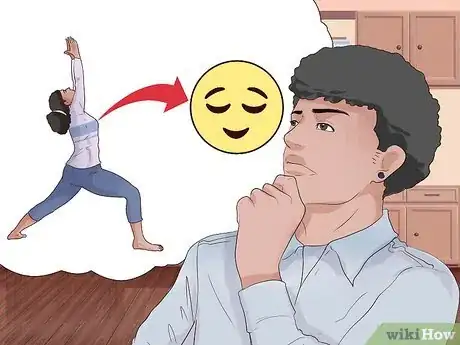

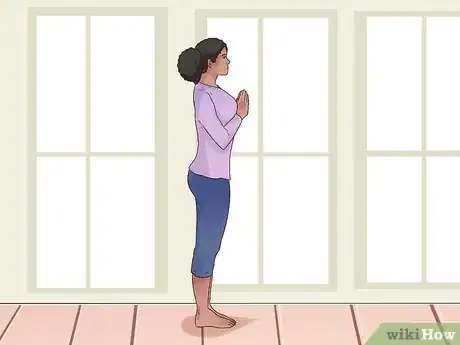
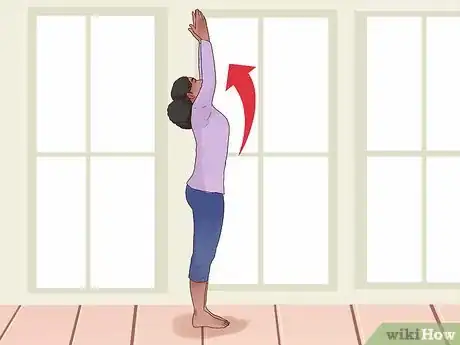

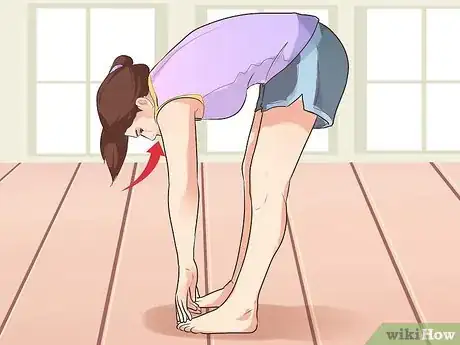

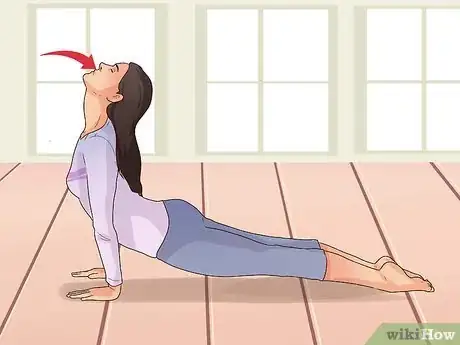


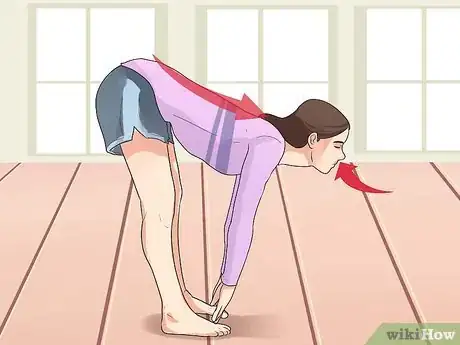




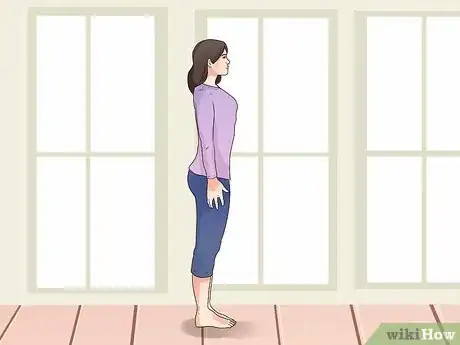

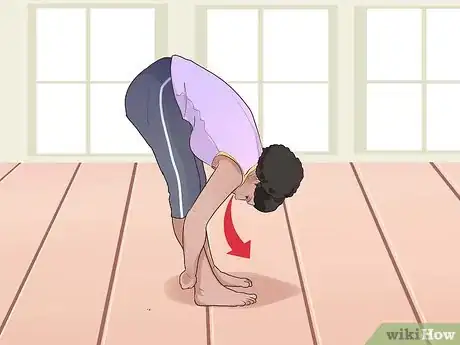
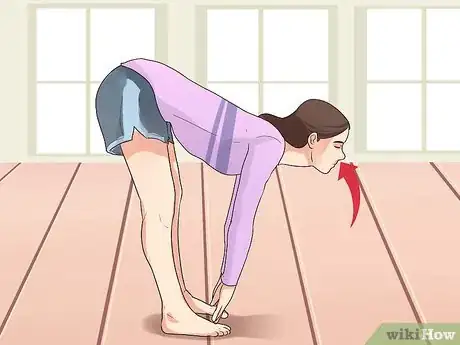
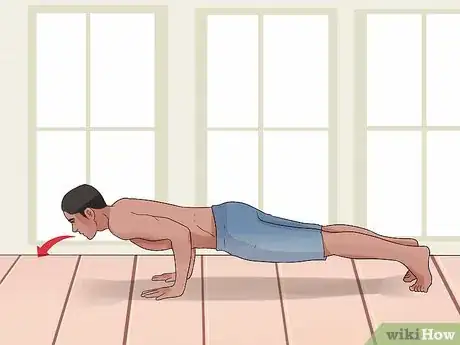

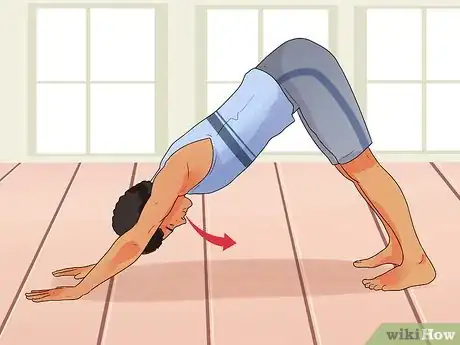


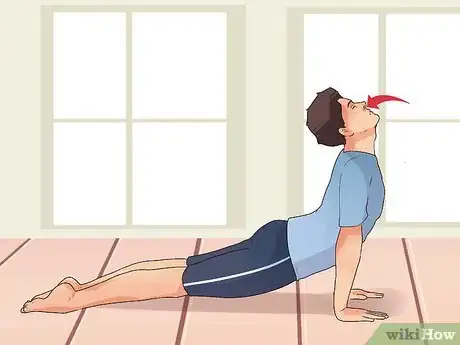



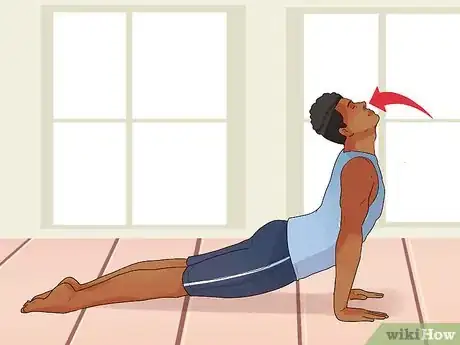
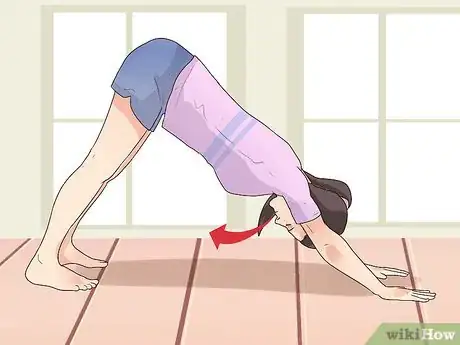
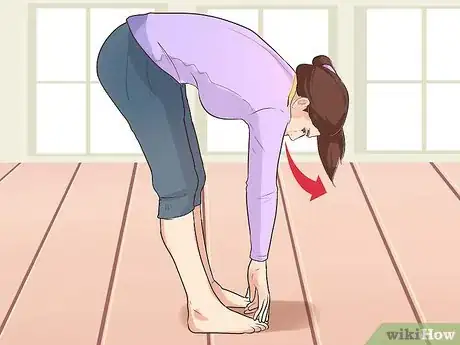




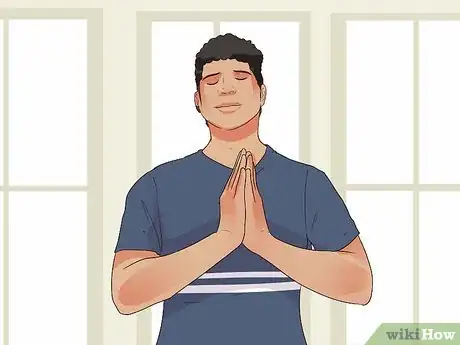

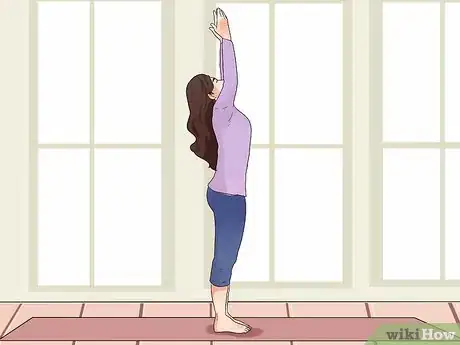

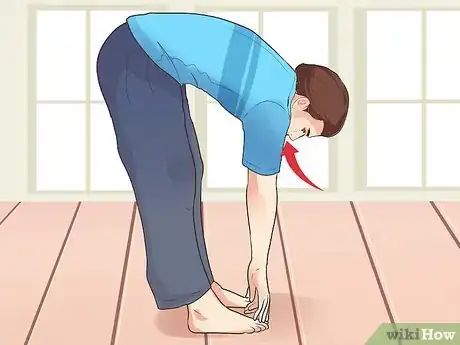



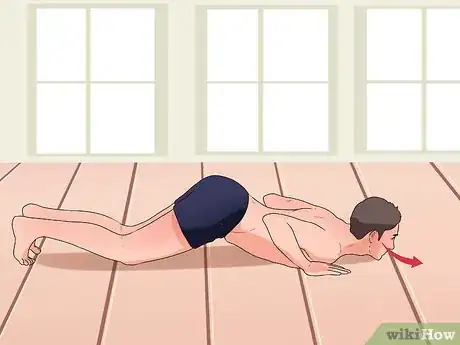





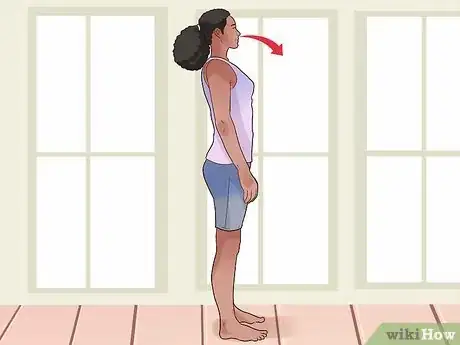
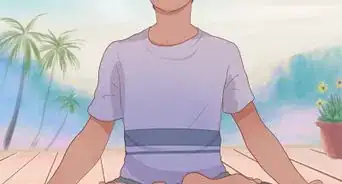



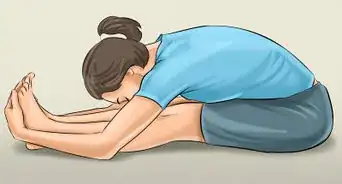




-Step-16.webp)












